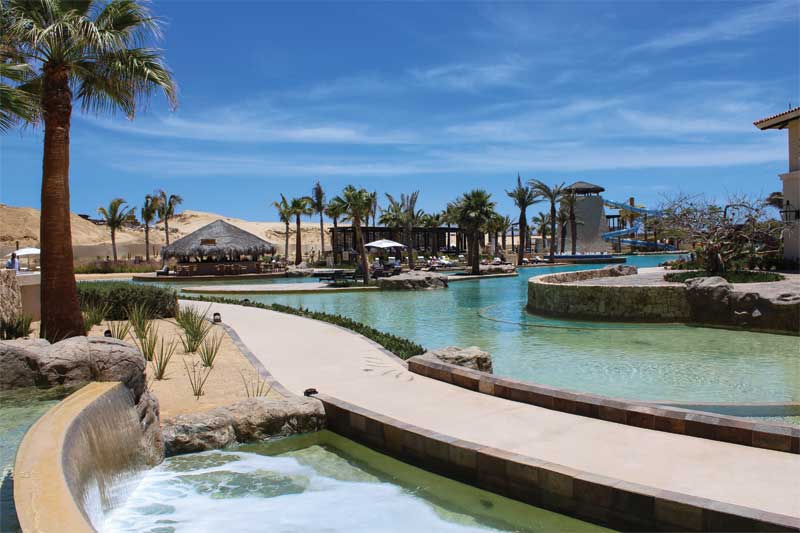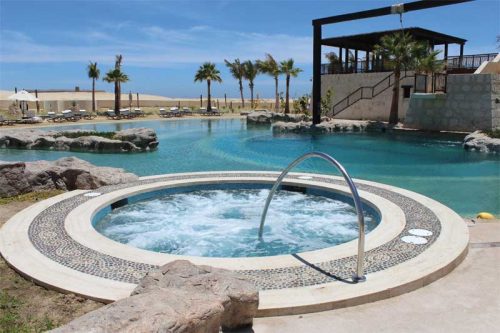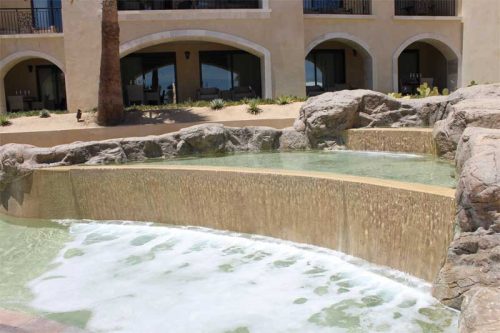By Juan Padilla

Nestled between sapphire seas and dramatic desert landscapes, the Grand Solmar—located within the exclusive Rancho San Lucas private resort community, just north of bustling Cabo San Lucas in Mexico—is above and beyond ordinary. This 0.20-ha (0.5-acre) luxury resort offers its guests a massive lagoon pool with a lazy river, waterslides, several infinity pools, and multiple swim-up bars for casual dining.
The lagoon is essentially an artificial seawater reservoir filled with saltwater from the adjacent Pacific Ocean. It offers users a beach entry complete with sandy shores to mimic the feel of the ocean within the resort. That said, the location of the lagoon and its unique features posed multiple challenges to the construction and maintenance of the pool. From building on top of a sand dune to battling corrosion and sanitation issues associated with saltwater, this lagoon construction was anything but simple.
The concept

Although the resort is located barely a few metres from the ocean, the rough waters of the beach were a deterrent for swimmers. Therefore, project developers conceived a lagoon pool design that would recreate the ambient landscape within the resort, complete with ocean water pumped directly into the lagoon from a well on the beach.
The resort has its own desalination plant that supplies the facility’s water, so a portion of the water is pumped directly into the pool from the same pumping system used by the plant. According to the project’s landscape architect, the lagoon provides users a beach experience and also doubles as a reservoir for the resort’s desalination plant.
Recreating the landscape
Baja California is essentially a desert next to the ocean, and building a pool in an arid zone is not easy.
“One of the biggest challenges was building this pool on top of (what is essentially) a sand dune,” says Xavier Alvarez, owner and CEO of Maxa Watershapes, and the co-designer, engineer, and builder of the lagoon. “Dealing with the sand and winds was a constant struggle, especially from October through February when the area experiences particularly high winds.”

The lagoon has a water surface of 4560 m2 (49,083 sf) and can hold nearly 3,406,871 L (900,000 gal) of water. The design also flaunts varying depths—from beach entries in several areas to shallow zones where the water is only 153 to 915 mm (6 to 36 in.) high and a maximum depth of almost 3 m (10 ft) in others.
The pool was built using reinforced concrete walls lined with polyvinyl chloride (PVC) and then covered with a layer of shotcrete to protect the vinyl. A berm was also constructed around the lagoon to prevent sand from getting into the water.
Multiple visual elements help accentuate the structure’s overall design—cascading rock water features spray and aerate the water, which simultaneously help with the circulation and flow. There is also a 3-m (10-ft) deep area with a diving tower. The two main water features—installed on opposite ends—provide the appearance of a natural waterfall and help to oxygenate the water. Due to the amount of water required to feed these features, four specialized pumps, offering a total flowrate of
9085 litres per minute (lpm) (2400 gallons per minute [gpm]), were installed.
Additional features adjacent to the lagoon that use non-saltwater include a show fountain with 14 bubblers and two spas—one on each end. Also, there are two waterslides and a children’s water play area next to the lagoon. All of these additional features require a separate equipment room far away from the main lagoon pump room to avoid long plumbing runs as well as to minimize the saltwater effects on the equipment. The water supply for these features, similar to the resort’s, comes from a huge desalinization plant.







Cool project–sounds incredibly challenging. Thanks for sharing!